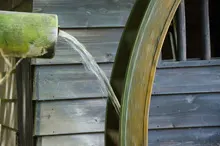
Hydro Energy And Flowing Water
Hydro Energy and the Potential of Flowing Water
![]() It might surprise you to know that hydro energy and flowing water has been around for millennia and that using the power of water to create energy, is one of the most efficient and cost effective of all the renewable energy sources available because it is very efficient at converting water power into electricity.
It might surprise you to know that hydro energy and flowing water has been around for millennia and that using the power of water to create energy, is one of the most efficient and cost effective of all the renewable energy sources available because it is very efficient at converting water power into electricity.
Because of this, it is also the most commonly utilized alternative energy source in the world today, with dams and hydro power stations providing a large majority of all our energy needs now and in the future.
In basic terms, hydro power is created by flowing water turning a large waterwheel or water turbine with the resulting rotation causes an energy output. But for the water to flow, it relies on gravity. So in essence, hydro power can be thought of as a combination of both water and gravity, because it’s gravity that causes the water to move in the first place.

Water power currently provides over 15% of the world’s energy needs. That figure on its own is impressive enough. But when you consider that mountainous countries like New Zealand use hydro power stations to create around 70% of their electrical power energy needs, you can begin to see the massive potential that hydro energy sources can offer the world.
By utilizing reservoirs and dams to control the flow of water, hydro power stations can create free renewable energy without burning any fossil fuels. Flowing water is a truly clean and renewable energy source and, once the resources are in place, is a relatively cheap way of producing electricity. In general, it is cheaper to produce energy in this manner than by the burning of fossil fuels.
The natural downward pull of the water by gravity is often enough for a power station’s needs, but in some cases it is necessary to create various canals and channels called penstocks to direct and increase the flow and speed of the water. This in turn increases the water’s potential energy and therefore the quantity of electricity that could be produced.
So How does Hydro Power Work
The creation of energy using water is in many ways similar to the creation of energy using wind power. The only difference is that the turbines are powered by the force of the water as opposed to the force of the air. Hydrokinetic energy has been used to a certain amount for hundreds of years, with waterwheels and watermills used for farming and other uses. However, due to recent massive leaps in technology over the past decades, it’s now possible to use that same principle on a much larger scale.
In very simple terms, a hydro power plant uses the kinetic energy of water movement to power enormous water turbines (or waterwheels). This therefore creates mechanical energy, which is then converted into electrical energy via a generator. How much energy is produced depends on the how fast the water moves the turbine. Therefore, the distance in height (known as “head height”) the water drops, along with the volume or amount of water will ultimately determine how much hydro energy is produced.
Hydro Energy and Flowing Water
If you’re lucky enough to live next to a river or fast running stream, it’s possible to build a small scale hydro power station to provide your home with renewable electricity.
Small scale hydro systems, also called micro generation systems, such as a “run of river” systems do not require a dam or storage facility to be constructed. Thus they are very easy to install for the average DIY person providing low maintenance requirements and running costs.
But if the river water isn’t flowing fast enough past your location then maybe the creation of a small dam can allow you to take advantage of this free energy source providing a great deal of your energy needs.
Because you’re not relying on the sun to shine or the wind to blow, using the potential energy of flowing water in this manner can truly provide you with electricity on a 24 hour basis.
After all, the rivers or streams never stop flowing giving a constant generation over long periods. Also in times of high rain or precipitation, the increased water flow in the rivers that this brings, means that the amount of potential energy and electricity generated by your systems will also increase.
By installing a small scale hydro energy station and either an AC or a DC generator to convert the energy created into power for your home, you really can take advantage of this “free energy” resource that is perhaps the most cost-effective and efficient of all the different types of alternative energy options available.
From the simplest of waterwheels through to a larger hydro station, the power of running water is one of the easiest to install, control and the cheapest to run. It’s even possible to link up a small scale hydro power station to the national grid using an inverter and be able to sell excess energy back to the utility companies.
As we said earlier, hydro power uses the tremendous power of flowing water and with a suitably designed and installed small scale hydro power station that drives a generator you can provide the electricity to your home and to the local community.
The advantage of the Cross Flow Turbine is its simplicity of construction and design based on concepts from both the impulse and reaction type turbine designs. The simplicity in its design reduces cost and makes it very suitable for low head and small hydro power schemes.
For more information about “Hydro Power” and how to generate your own electricity using the power of water, or obtain more hydro energy information about the various small scale hydro power systems available, or to explore the advantages and disadvantages of using hydro energy as a renewable energy resource, then Click Here to order your copy of the top selling hydro power book from Amazon today explaining in detail all about small scale and low head hydro systems which can be used for generating electricity.











Very much interested in building a small hydro to power my home. We have a waterfall and a fast moving creek/stream that runs by our house on our property.
Overshot waterwheels are always streets ahead of undershot as far as efficiency is concerned, but I presume the undershot is in the stream as it were. What if I had an undershot and introduced the water at the bottom of my 5.4 meter fall? Surely I would have a faster wheel and therefore not the same loses through gearing etc. to my generator.